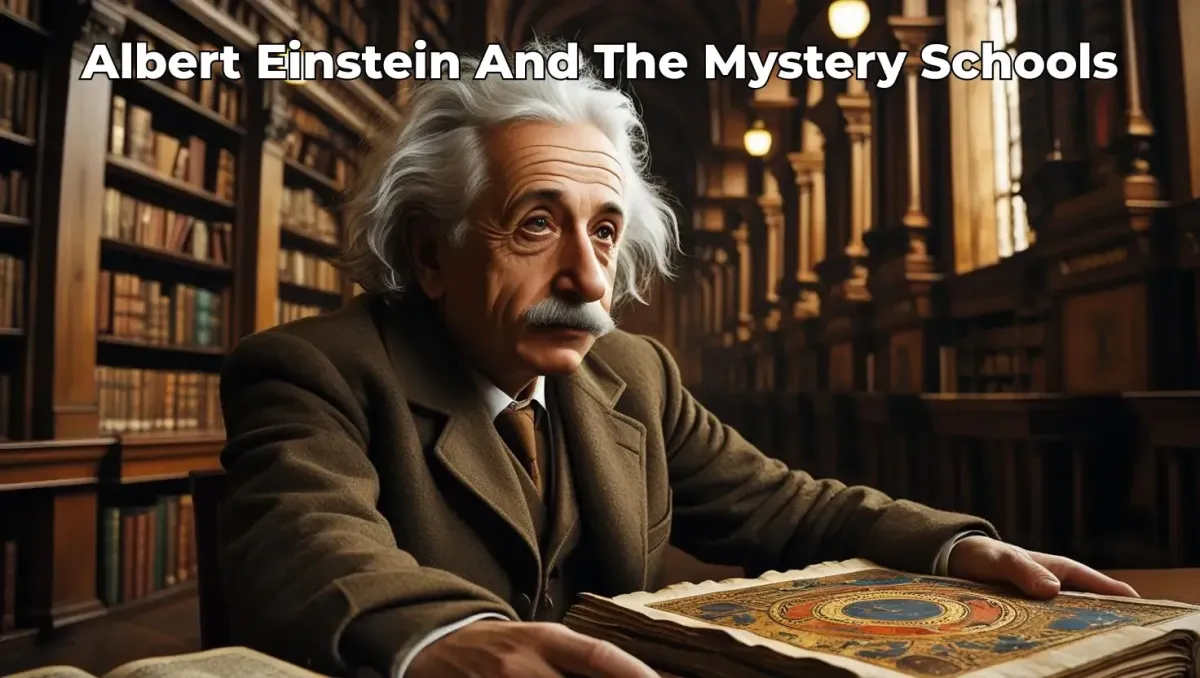
Albert Einstein and Esoteric Wisdom: How Mystery Schools Shaped His Vision
Albert Einstein (1879–1955) is celebrated as the genius who reshaped physics with his theory of relativity, unlocking a new vision of space, time, and energy. Yet behind the mathematics and scientific breakthroughs lay a mind that resonated deeply with esoteric wisdom and the traditions of the mystery schools.
Einstein’s reflections reveal not only a physicist but a philosopher of the unseen — a man who valued intuition, imagination, and the search for unity. His ideas echo the Hermetic and mystical teachings that for centuries guided initiates into deeper understanding of the cosmos.
New to mystery schools? Start with our overview article “What Are Mystery Schools?” and then visit the Mystery School hub for classes, courses and next steps.

Einstein and "The Mysterious" — Fact Vs Myth (Plain English)
Einstein was a physicist, not an initiate of any esoteric order. He did, however, write that “the most beautiful experience we can have is the mysterious,” linking wonder to the roots of art, science, and a non-dogmatic “religious” feeling. Read this as reverence for nature’s order, not evidence of occult membership. (history.aip.org)
Spinoza’s God, not a personal deity
In 1929 Einstein replied to Rabbi Herbert Goldstein that he believed in Spinoza’s God—the lawful harmony of nature—not in a God who intervenes in human affairs. In 1930 he described a mature “cosmic religious feeling” that awakens awe without theology. In 1954, in the famous “God letter,” he rejected a personal God outright. Treat his language as metaphor and humility before natural law. (Jewish Telegraphic Agency)
Why Einstein appears in “mystery school” conversations
He modelled disciplined wonder — curiosity guided by method.
He held a philosophy of science that blends creativity with testable claims, wary of dogma.
His fame tempts people to retrofit occult stories onto him. Keep the record clear and the inspiration intact. (Stanford Encyclopedia of Philosophy)
A quick timeline for context
1915–1919: General Relativity proposed; light-bending reported after the 1919 eclipse expeditions (Eddington, Dyson, Davidson). This turned Einstein into a global icon of science. (Royal Society Publishing)
1930: “Religion and Science” essay explains fear-based religion vs social morality vs cosmic religious feeling. (Internet Sacred Text Archive)
1954: Letter to Eric Gutkind clarifies his stance against a personal God. (The Guardian)
The Mystery School Approach to Knowledge
Einstein once wrote:
“The most beautiful thing we can experience is the mysterious. It is the source of all true art and science.”
This statement captures the mystery school spirit. Ancient initiates were not content with surface explanations — they sought the hidden forces and universal patterns shaping existence.
Einstein, too, approached science not as a cold collection of facts, but as a living pursuit of wonder. For him, imagination was as vital as logic. He often remarked that intuition was superior to intellect, a belief deeply aligned with esoteric traditions.
Hermetic Parallels in Einstein’s Vision
Einstein’s theories often parallelled Hermetic principles. Consider his famous equation, E = mc², which shows that energy and matter are interchangeable. This reflects the Hermetic teaching of correspondence and transformation, where different forms of reality mirror each other (The Hermetic Principles: Universal Laws of the Mystery Schools).
Other resonances include:
Unity of forces: Einstein’s lifelong search for a unified field theory mirrors the Hermetic ideal of an interconnected cosmos.
As above, so below: Relativity revealed that time and space shift relative to perspective — echoing the mystery school teaching that reality is shaped by the level of consciousness.
The Principle of Vibration: Quantum physics, which grew from Einstein’s work, affirms that matter is not solid but vibrational energy — a restatement of Hermetic law.
The Role of Intuition and Imagination
Einstein frequently admitted that his insights came not from calculation alone but from sudden visions and intuitive leaps. He described daydreaming about riding a beam of light, an image that ultimately led to his special theory of relativity.
This reliance on imagination mirrors esoteric meditation practices, where visualisation and inner vision were pathways to knowledge (Esoteric Meditation: Initiatory Practices for Inner Vision).
In mystery schools, imagination was not “fantasy” but a higher faculty — a bridge between human consciousness and universal truth. Einstein’s work stands as a modern demonstration of this principle.
Einstein and Spinoza: A Pantheistic Vision
Einstein openly declared his admiration for Baruch Spinoza, the philosopher whose pantheism saw God as identical with the order of the universe. Einstein said:
“I believe in Spinoza’s God, who reveals himself in the orderly harmony of what exists.”
This echoes the metaphysical and ontological pursuits of the mystery schools — the quest to understand being, existence, and divine structure (Metaphysics & Ontology: Mystery Schools and the Nature of Reality).
Like the Hermetic sages, Einstein believed the universe was suffused with intelligence and harmony, not random chaos.
The Mystical Side of a Scientist
Einstein was not a practitioner of ritual magic or formal esotericism like John Dee (John Dee: Hidden Knowledge of the Renaissance Mystery Schools), but his writings show mystical tendencies:
He spoke of a “cosmic religious feeling” as the highest spiritual experience.
He valued awe and wonder above dogma or doctrine.
He saw himself as a humble seeker before the vast mystery of existence.
In this, he stands in line with mystery school initiates, who prized humility, devotion, and the willingness to dwell in mystery.
Einstein and the Quantum Enigma
Though Einstein resisted some interpretations of quantum mechanics, his contributions to the field opened the door to ideas remarkably close to esoteric thought. Quantum theory showed that reality is not fixed but probabilistic, relational, and shaped by observation.
This resonates with:
Kabbalah, where divine emanations shift according to consciousness (Kabbalah and Hermetic Qabalah: The Tree of Life in Mystery Schools).
Alchemy, where matter and spirit transform in response to awareness (Alchemy and the Mystery Schools: The Inner Gold of Transformation).
Compassion-based energy work, which affirms that intention and heart resonance shape the energetic field (Compassion-Based Energy Work: Heart-Centred Alchemy in the Mystery Tradition).
Einstein’s discomfort with quantum uncertainty only underscores his longing for unity — another Hermetic aspiration.
The Influence of Mystery School Thought
While there is no evidence Einstein formally studied Hermetic texts, his worldview reflects the mystery school approach:
Unity of all things — the cosmos as an interconnected whole.
Imagination as revelation — inner vision as a source of knowledge.
Harmony of the universe — divine order expressed through mathematics.
Reverence for mystery — wisdom begins with awe.
In these ways, Einstein carried the torch of ancient wisdom into the modern scientific era.
Safety & discernment — a quick note
Let Einstein’s example sharpen your discernment. Prefer teachers who celebrate curiosity and evidence. Avoid groups that name-drop science to sell promises, demand secrecy for payment, or make miracle claims. Look for transparent pricing, refunds, boundaries and aftercare. If your body says “no,” pause and seek another view.
Next Steps On Your Mystery School Path
If this article spoke to you, don’t leave it as just an interesting idea. Take one gentle step to deepen the journey.
·Visit the Mystery School hub to see all classes and courses in one place.
·Explore the 7 Hermetic Principles for a structured, step-by-step dive into the philosophical backbone behind this theme.
Continue reading with these related articles:
The Hermetic Principles: Universal Laws of the Mystery Schools
Metaphysics & Ontology: Mystery Schools and the Nature of Reality
Choose the one that feels kindest and most alive for you right now, and let the work unfold at your own pace.

Albert Einstein was not just a physicist but a mystic in disguise — a man who saw science as a pathway to divine mystery. His insights continue to inspire seekers who long to unite reason with reverence.
At the Bright Beings Academy Mystery School, we explore the very wisdom Einstein intuited — from Hermetic principles to metaphysics and sacred geometry.

FAQs on Albert Einstein and the Mystery Schools
Did Einstein study Hermeticism directly?
Not directly, but his worldview mirrors Hermetic and mystical ideas.
What is Einstein’s “cosmic religious feeling”?
It was his way of describing a deep spiritual reverence for the harmony of the universe without attachment to dogma.
How did imagination guide Einstein’s discoveries?
Through visualisations and thought experiments that mirrored esoteric meditation practices.
Was Einstein part of a mystery school?
No evidence supports that. He was a theoretical physicist with a public record of papers, letters and essays. The “mysterious” quote is about wonder in science, not occult initiation. (history.aip.org)
What did he mean by “Spinoza’s God”?
A non-personal divinity expressed as the lawful harmony of nature. It rejects a deity who intervenes in daily life. (Jewish Telegraphic Agency)
Did he believe in any religion?
He spoke of a cosmic religious feeling—awe before order and beauty—without dogma. (Internet Sacred Text Archive)
Why do people tie him to occult ideas?
Fame, metaphorical language, and the allure of authority. The archives and serious scholarship paint a grounded picture. (Stanford Encyclopedia of Philosophy)
What’s one scientific milestone that made him a household name?
The 1919 eclipse results publicised light-bending near the Sun, a prediction of General Relativity. (Royal Society Publishing)
Further reading
Neoplatonism and Theurgy: The Simple Map Behind Western Mysticism
The Emerald Tablet and As Above, So Below: A Plain-English Explainer
How to Vet a Mystery School: Ethics, Fees, Promises & Red Flags
I look forward to connecting with you in my next post.
Until then, be well and keep shining.
Peter. :)
